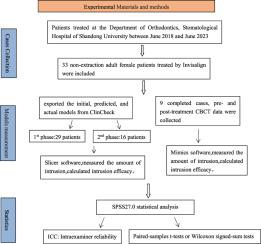成年女性未拔除深覆咬合患者用清晰矫正器治疗门牙侵入的准确性。
IF 5.5
2区 医学
Q1 DENTISTRY, ORAL SURGERY & MEDICINE
引用次数: 0
摘要
目的:评价使用透明矫正器(Invisalign, Align Tech, USA)治疗的成年女性非拔牙深覆咬合患者切牙侵入的准确性,并探讨透明矫正器治疗深覆咬合矫正的可预测性。方法:这项回顾性研究包括33名成年女性患者,她们接受了不拔牙治疗,随后接受了透明矫正器治疗。从ClinCheck导出了初始的、预测的和实际的模型。对于9例已完成的病例,收集了治疗前后的锥束计算机断层扫描(CBCT)数据。测量了前切牙的咬合量,计算了牙齿的咬合效果和深度覆盖矫正量。采用配对样本t检验或Wilcoxon符号秩检验(显著性P < 0.05)进行统计分析,计算临床意义差异的效应量(Cohen’s d),使用类内相关系数(ICC)评估检查者内部信度。结果:各牙体垂直运动预测值与实际值有显著性差异,上颌中切牙垂直运动预测值差异最大。第一阶段深部覆咬合矫治的平均侵入精度为45.54%。在完成的病例中,深度复咬的平均矫正率为41.18%,与第一阶段(初始治疗阶段)的结果相当。结论:在未拔牙的成年女性患者中,第一阶段使用矫正器矫正牙合效果最好,而额外的矫正治疗并没有显著提高正畸效果。几乎每个深覆咬的患者都需要一定程度的过矫和进一步的精细治疗来达到最佳效果。临床意义:本研究旨在i)评估几种改良方法在深度覆盖咬合矫正中门牙侵入的准确性,ii)确定矫正器不同阶段单个牙齿垂直运动的差异,以及iii)评估清晰矫正器用于深度覆盖咬合矫正的可预测性。本文章由计算机程序翻译,如有差异,请以英文原文为准。

Accuracy of incisor intrusion in adult female nonextraction deep overbite cases with clear aligner treatment
Objective
To evaluate the accuracy of incisor intrusion in nonextraction deep overbite cases in adult female patients treated with clear aligners (Invisalign, Align Tech, USA), and to investigate the predictability of clear aligner treatment for deep overbite correction.
Methods
This retrospective study included thirty-three adult female patients who underwent nonextraction followed by clear aligner treatment. The initial, predicted, and actual models were exported from ClinCheck. For nine completed cases, pre- and posttreatment cone-beam computed tomography (CBCT) data were collected. The amount of intrusion achieved for the incisors was measured, and the intrusion efficacy and deep overbite correction were calculated. Statistical analysis was performed using paired-samples t tests or Wilcoxon signed-rank tests (significance set at P < 0.05), with effect sizes (Cohen's d) calculated for clinically meaningful differences and intraexaminer reliability assessed using the intraclass correlation coefficient (ICC).
Results
Significant differences were observed between the predicted and actual vertical movements of all teeth, with the greatest discrepancy observed in the maxillary central incisors. The average accuracy of intrusion for deep overbite correction in the first phase was 45.54 %. For the completed cases, the average correction for deep overbite was 41.18 %, which was comparable to the results achieved in the 1st phase (intital treatment stage).
Conclusions
In nonextraction adult female patients treated with clear aligners, the first phase demonstrated the most overbite correction with aligners, whereas additional refinement treatment did not significantly enhance the orthodontic outcome. Almost every patient with deep overbite required some degree of overcorrection and further refinement treatments to achieve optimal results.
Clinical Significance
This study aimed to i) evaluate the accuracy of incisor intrusion with deep overbite correction over several refinements, ii) determine the discrepancy of individual teeth in vertical movements in the different phases of the aligners, and iii) assess the predictability of clear aligners for deep overbite correction.
求助全文
通过发布文献求助,成功后即可免费获取论文全文。
去求助
来源期刊

Journal of dentistry
医学-牙科与口腔外科
CiteScore
7.30
自引率
11.40%
发文量
349
审稿时长
35 days
期刊介绍:
The Journal of Dentistry has an open access mirror journal The Journal of Dentistry: X, sharing the same aims and scope, editorial team, submission system and rigorous peer review.
The Journal of Dentistry is the leading international dental journal within the field of Restorative Dentistry. Placing an emphasis on publishing novel and high-quality research papers, the Journal aims to influence the practice of dentistry at clinician, research, industry and policy-maker level on an international basis.
Topics covered include the management of dental disease, periodontology, endodontology, operative dentistry, fixed and removable prosthodontics, dental biomaterials science, long-term clinical trials including epidemiology and oral health, technology transfer of new scientific instrumentation or procedures, as well as clinically relevant oral biology and translational research.
The Journal of Dentistry will publish original scientific research papers including short communications. It is also interested in publishing review articles and leaders in themed areas which will be linked to new scientific research. Conference proceedings are also welcome and expressions of interest should be communicated to the Editor.
 求助内容:
求助内容: 应助结果提醒方式:
应助结果提醒方式:


